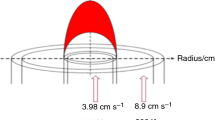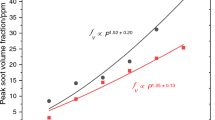Abstract
To comprehensively understand the effect of horizontal opening size on the soot evolution and transportation of flames in the confined compartment, 2D soot distribution and characteristic soot volume fraction of non-premixed propane flames were theoretically and experimentally investigated in the confined compartment (0.2 m × 0.2 m × 0.2 m) with different horizontal openings (0.03 m to 0.10 m) in this work. The oxygen concentration supplied by the horizontal opening was determined by the ratio of dimensionless opening size and dimensionless flame volume within a range of 14.5% to 20.7%. Results showed that the soot distribution of non-premixed propane flames in the confined compartment with a horizontal opening complied with the classical three-zone assumption. The maximum soot volume fraction, the characteristic length of the soot formation zone and the characteristic length of the soot oxidation zone were all positively related to the dimensionless flame volume and negatively correlated with the dimensionless opening size. There was a positive correlation between the ratio of two characteristic lengths and dimensionless flame volume, and the correlation was independent of the dimensionless opening size. Moreover, a linear correlation of characteristic soot volume fraction was proposed to predict the maximum soot volume fraction of non-premixed flames in the confined compartment with a horizontal opening.












Similar content being viewed by others
References
Seinfeld J, Pandis S (2008) Atmospheric chemistry and physics, 1997. New York
Cheung SC, Yuen RK, Yeoh G, Cheng GW (2004) Contribution of soot particles on global radiative heat transfer in a two-compartment fire. Fire Saf J 39:412–428
Mahmoud S, Nathan G, Medwell P, Dally B, Alwahabi Z (2015) Simultaneous planar measurements of temperature and soot volume fraction in a turbulent non-premixed jet flame. Proc Combust Inst 35:1931–1938
Kearney SP, Grasser TW (2017) Laser-diagnostic mapping of temperature and soot statistics in a 2-m diameter turbulent pool fire. Combust Flame 186:32–44
Jiang P, Zhou M, Wen D, Wang Y (2021) An experimental multiparameter investigation on the thermochemical structures of benchmark ethylene and propane counterflow diffusion flames and implications to their numerical modeling. Combust Flame 234:111622
Mannazhi M, Török S, Gao J, Bengtsson P-E (2021) Soot maturity studies in methane-air diffusion flames at elevated pressures using laser-induced incandescence. Proc Combust Inst 38:1217–1224
Wei Y, Zhang J, Nadjai A, Beji T, Delichatsios MA (2011) A global soot model developed for fires: validation in laminar flames and application in turbulent pool fires. Fire Saf J 46:371–387
Kruse S, Medwell P, Davidovic M, Sun Z, Ye J, Pitsch H, Dally BB (2021) The effect of fuel composition and Reynolds number on soot formation processes in turbulent non-premixed toluene jet flames. Proc Combust Inst 38:1395–1402
Liu F, Guo H, Smallwood GJ, Gülder ÖL (2003) Numerical modelling of soot formation and oxidation in laminar coflow non-smoking and smoking ethylene diffusion flames. Combust Theor Model 7:301
Hoerlle CA, França FHR, Pagot PR, Pereira FM (2020) Effects of radiation modeling on non-premixed sooting flames simulations under oxyfuel conditions. Combust Flame 217:294–305
Delichatsios MA (1994) A phenomenological model for smoke-point and soot formation in laminar flames. Combust Sci Technol 100:283–298
Beji T, Zhang JP, Delichatsios M (2008) Determination of soot formation rate from laminar smoke point measurements. Combust Sci Technol 180:927–940
Lee KB, Thring MW, Beér J (1962) On the rate of combustion of soot in a laminar soot flame. Combust Flame 6:137–145
Leung KM, Lindstedt RP, Jones WP (1991) A simplified reaction mechanism for soot formation in nonpremixed flames. Combust Flame 87:289–305
Wang H (2011) Formation of nascent soot and other condensed-phase materials in flames. Proc Combust Inst 33:41–67
Moss J, Aksit I (2007) Modelling soot formation in a laminar diffusion flame burning a surrogate kerosene fuel. Proc Combust Inst 31:3139–3146
Yuen ACY (2014) On the prediction of combustion products and soot particles in compartment fires. University of New South Wales.
Yuen A, Yeoh G, Timchenko V, Cheung S, Barber T (2016) Importance of detailed chemical kinetics on combustion and soot modelling of ventilated and under-ventilated fires in compartment. Int J Heat Mass Transfer 96:171–188
Yuen A, Yeoh G, Timchenko V, Chen T, Chan Q, Wang C, Li D (2017) Comparison of detailed soot formation models for sooty and non-sooty flames in an under-ventilated ISO room. Int J Heat Mass Transfer 115:717–729
Ko GH, Hamins A, Bundy M, Johnsson EL, Kim SC, Lenhert DB (2009) Mixture fraction analysis of combustion products in the upper layer of reduced-scale compartment fires. Combust Flame 156:467–476
Sahu D, Jain S, Gupta A, Kumar S (2019) Experimental studies on different liquid pool fires inside the compartment. Fire Saf J 109:102858
Yuan M, Chen B, Li C, Zhang J, Lu S (2013) Analysis of the combustion efficiencies and heat release rates of pool fires in ceiling vented compartments. Procedia Eng 62:275–282
Chen X, Lu S, Ding Z (2020) Initial fuel depth effect on the burning characteristics of thin-layer pool fire in a confined enclosure. J Therm Anal Calorim 139:1409–1418
Guo F, Wang C, Zhang J (2018) Spray fire induced gas temperature characteristics and correlations in a ceiling ventilated compartment. Int J Therm Sci 134:188–199
He Q, Ezekoye OA, Li C, Lu S (2015) Ventilation limited extinction of fires in ceiling vented compartments. Int J Heat Mass Transfer 91:570–583
Chen X, Lu S, Wang X, Liew KM, Li C, Zhang J (2016) Pulsation behavior of pool fires in a confined compartment with a horizontal opening. Fire Technol 52:515–531
Ding Z, Chen X, Lu S, Wang Y (2020) An investigation of flame tilt transition inside the compartment with horizontal opening in cross wind. Proc Combust Inst. https://doi.org/10.1016/j.proci.2020.07.085
Zhang P, Liu H-F, Chen B-L, Tang Q-L, Yao M-F (2015) Fluorescence spectra of polycyclic aromatic hydrocarbons and soot concentration in partially premixed flames of diesel surrogate containing oxygenated additives. Wuli Huaxue Xuebao 31:32–40
Lautenberger CW, Ris J, Dembsey NA, Barnett JR, Baum HR (2005) A simplified model for soot formation and oxidation in CFD simulation of non-premixed hydrocarbon flames. Fire Saf J 40:141–176
Lide DR (2006) CRC handbook of chemistry and physics, 86th edition. J Am Chem Soc 128:5585
Zhang J, Lu S, Li C, Yuan M, Yuen R (2013) On the self-extinction time of pool fire in closed compartments. Procedia Eng 62:266–274
Quintiere JG (2006) Fundamentals of fire phenomena. Wiley, New York
Xin Y, Gore JP (2005) Two-dimensional soot distributions in buoyant turbulent fires. Proc Combust Inst 30:719–726
Qamar N, Nathan G, Alwahabi Z, King K (2005) The effect of global mixing on soot volume fraction: measurements in simple jet, precessing jet, and bluff body flames. Proc Combust Inst 30:1493–1500
Qamar N, Alwahabi Z, Chan Q, Nathan G, Roekaerts D, King K (2009) Soot volume fraction in a piloted turbulent jet non-premixed flame of natural gas. Combust Flame 156:1339–1347
Köhler M, Geigle KP, Meier W, Crosland BM, Thomson KA, Smallwood GJ (2011) Sooting turbulent jet flame: characterization and quantitative soot measurements. Appl Phys B 104:409–425
Quay B, Lee T-W, Ni T, Santoro R (1994) Spatially resolved measurements of soot volume fraction using laser-induced incandescence. Combust Flame 97:384–392
Schulz C, Kock BF, Hofmann M, Michelsen H, Will S, Bougie B, Suntz R, Smallwood G (2006) Laser-induced incandescence: recent trends and current questions. Appl Phys B 83:333–354
Moreau CS, Therssen E, Mercier X, Pauwels J, Desgroux P (2004) Two-color laser-induced incandescence and cavity ring-down spectroscopy for sensitive and quantitative imaging of soot and PAHs in flames. Appl Phys B 78:485–492
Hebert D, Coppalle A, Talbaut M (2013) 2d soot concentration and burning rate of a vertical pmma slab using laser-induced incandescence. Proc Combust Inst 34:2575–2582
Melton LA (1984) Soot diagnostics based on laser heating. Appl Opt 23:2201–2208
de Francqueville L, Bruneaux G, Thirouard B (2010) Soot volume fraction measurements in a gasoline direct injection engine by combined laser induced incandescence and laser extinction method. SAE Int J Engines 3:163–182
Widmann J, Yang JC, Smith T, Manzello S, Mulholland GW (2003) Measurement of the optical extinction coefficients of post-flame soot in the infrared. Combust Flame 134:119–129
Williams TC, Shaddix CR, Jensen KA, Suo-Anttila JM (2007) Measurement of the dimensionless extinction coefficient of soot within laminar diffusion flames. Int J Heat Mass Transfer 50:1616–1630
Zhao H, Ladommatos N (1998) Optical diagnostics for soot and temperature measurement in diesel engines. Prog Energy Combust Sci 24:221–255
Chen X, Lu S (2018) Fire-induced horizontal vent flow pattern in a ceiling vented enclosure: theoretical analysis and experimental verification. In: Asia-Oceania symposium on fire science and technology, pp 167–179
Beji T, Zhang J, Delichatsios M (2008) Soot formation and oxidation in fires from laminar smoke point measurements. Fire Saf. Sci. 9:219–230
Acknowledgements
This work was sponsored by National Natural Science Foundation of China (Grant No. 51704268), Fundamental Research Funds for the Central Universities (Nos. WK2320000044 and WK2320000048).
Author information
Authors and Affiliations
Corresponding authors
Additional information
Publisher's Note
Springer Nature remains neutral with regard to jurisdictional claims in published maps and institutional affiliations.
Rights and permissions
Springer Nature or its licensor (e.g. a society or other partner) holds exclusive rights to this article under a publishing agreement with the author(s) or other rightsholder(s); author self-archiving of the accepted manuscript version of this article is solely governed by the terms of such publishing agreement and applicable law.
About this article
Cite this article
Yao, W., Chen, X. & Lu, S. Investigation of 2D Soot Distribution and Characteristic Soot Volume Fraction of Flames in the Confined Compartment with a Horizontal Opening. Fire Technol 59, 497–516 (2023). https://doi.org/10.1007/s10694-022-01354-8
Received:
Accepted:
Published:
Issue Date:
DOI: https://doi.org/10.1007/s10694-022-01354-8




